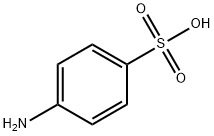4-Aminobenzamidine dihydrochloride
Synonym(s):p-Aminobenzimidamide dihydrochloride
- CAS NO.:2498-50-2
- Empirical Formula: C7H11Cl2N3
- Molecular Weight: 208.09
- MDL number: MFCD00013001
- EINECS: 219-692-2
- SAFETY DATA SHEET (SDS)
- Update Date: 2025-12-05 14:33:18

What is 4-Aminobenzamidine dihydrochloride?
Chemical properties
white to yellowish fine crystalline powder
The Uses of 4-Aminobenzamidine dihydrochloride
4-Aminobenzamidine dihydrochloride is a synthetic diamidine derivative that acts as a urokinase inhibitor as well as trypsin inhibitor. It is used as a ligand in affinity chromatography for purification and immobilization of enzymes.
What are the applications of Application
4-Aminobenzamidine dihydrochloride can be used to synthesize:
Orally active fibrinogen receptor antagonists based on benzamidines.
Benzamidine derivatives that are selective and potent serine protease inhibitors.
Novel pyrrolo [3,2-c] quinolines that are structural analogs of topoisomerase inhibitors such as coralyne and fagaronine.
Synthesis of a selective inhibitor of PRMT1 (SKLB-639)
Preparation
4-Aminobenzamididine dihydrochloride is obtained by cyanation, addition, amination and reduction of 4-nitrobenzoic acid.
Definition
ChEBI: P-Aminobenzamidine dihydrochloride is an organic molecular entity.
Properties of 4-Aminobenzamidine dihydrochloride
| Melting point: | >300 °C(lit.) |
| storage temp. | 2-8°C |
| solubility | DMSO (Slightly), Water |
| form | Fine Crystalline Powder |
| color | White to yellow |
| Sensitive | Hygroscopic |
| BRN | 3692927 |
| Stability: | Hygroscopic |
| CAS DataBase Reference | 2498-50-2(CAS DataBase Reference) |
Safety information for 4-Aminobenzamidine dihydrochloride
| Signal word | Warning |
| Pictogram(s) |
 Exclamation Mark Irritant GHS07 |
| GHS Hazard Statements |
H315:Skin corrosion/irritation H319:Serious eye damage/eye irritation H335:Specific target organ toxicity, single exposure;Respiratory tract irritation |
| Precautionary Statement Codes |
P261:Avoid breathing dust/fume/gas/mist/vapours/spray. P264:Wash hands thoroughly after handling. P264:Wash skin thouroughly after handling. P280:Wear protective gloves/protective clothing/eye protection/face protection. P304+P340:IF INHALED: Remove victim to fresh air and Keep at rest in a position comfortable for breathing. P305+P351+P338:IF IN EYES: Rinse cautiously with water for several minutes. Remove contact lenses, if present and easy to do. Continuerinsing. P405:Store locked up. |
Computed Descriptors for 4-Aminobenzamidine dihydrochloride
| InChIKey | GHEHNICLPWTXJC-UHFFFAOYSA-N |
New Products
Indole Methyl Resin tert-butyl 9-methoxy-3-azaspiro[5.5]undecane-3-carboxylate Boc-His(Boc)-OH 2-CTC Resin 4-Chloro-7-tosy1-7Hpyrrolo[2,3-d]pyrimidine 5,7-Dibromo-1H-indole 2,5-dichloro-N-hydroxy-4,6-dimethylpyridine-3-carboximidamide 2,2-Dimethoxy-7-azaspiro[3.5]nonane hydrochloride 4-chloromethyl-5-methyl-1,3-dioxol-2-one (DMDO-Cl) R-2-BENZYLOXY PROPIONIC ACID 1,1’-CARBONYLDIIMIDAZOLE 1,1’-CARBONYLDI (1,2-4 TRIAZOLE) N-METHYL INDAZOLE-3-CARBOXYLIC ACID 4-((2-hydroxyethyl)thio)benzoic acid 1-(TERT-BUTOXYCARBONYL)-2-PYRROLIDINONE Methyl 6-methylnicotinate 3-Pyridineacrylic acid tert-Butyl carbazate TETRAHYDRO-2H-PYRAN-3-OL 2-((4-morpholinophenylamino) (methylthio) methylene) malononitrile 3-(4-morpholinophenylamino)-5-amino-1H-pyrazole-4-carbonitrile 2,4-dihydroxybenzaldehyde 1,3-Diethyl-1,3-Diphenylurea Methyl 2-methylquinoline-6-carboxylateRelated products of tetrahydrofuran








You may like
-
 2498-50-2 4-Aminobenzamidine Dihydrochloride 98%View Details
2498-50-2 4-Aminobenzamidine Dihydrochloride 98%View Details
2498-50-2 -
 2498-50-2 98%View Details
2498-50-2 98%View Details
2498-50-2 -
 4-Aminobenzamidine dihydrochloride 98%View Details
4-Aminobenzamidine dihydrochloride 98%View Details
2498-50-2 -
 4-Aminobenzamidine dihydrochloride 2498-50-2 99%View Details
4-Aminobenzamidine dihydrochloride 2498-50-2 99%View Details
2498-50-2 -
 4-Aminobenzamidine Dihydrochloride CAS 2498-50-2View Details
4-Aminobenzamidine Dihydrochloride CAS 2498-50-2View Details
2498-50-2 -
 4-Aminobenzamidine dihydrochloride CAS 2498-50-2View Details
4-Aminobenzamidine dihydrochloride CAS 2498-50-2View Details
2498-50-2 -
 4-Aminobenzamidine dihydrochloride CAS 2498-50-2View Details
4-Aminobenzamidine dihydrochloride CAS 2498-50-2View Details
2498-50-2 -
 Thiourea 99% ARView Details
Thiourea 99% ARView Details
62-56-6
